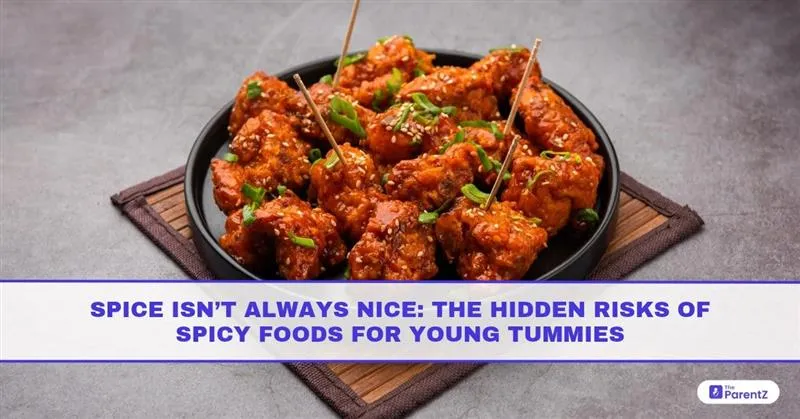A Little Too Much Heat on the Plate?
Spices are woven into the fabric of Indian cuisine. From the red heat of mirchi powder to the complex punch of garam masala, we take pride in our flavourful meals. But what’s delicious for adults may be distressing for children, especially when it comes to spicy foods. As a dentist working closely with children, I’ve seen firsthand how food choices influence not just oral health, but also digestion, feeding behaviour, and sensitivity. Many well-meaning parents offer their children the same spicy meals they eat themselves, often believing that “they’ll get used to it.” But children aren’t miniature adults; their digestive systems, taste receptors, and oral tissues are still developing.
Why Are Spicy Foods a Problem for Children?
Immature Digestive Systems
The gastrointestinal tract in young children is still growing. It’s more sensitive to irritants like chilli powder, green chilies, and pepper-based sauces. When these foods are consumed regularly or in large amounts, they may lead to:
- Gastric irritation
- Stomach pain
- Acid reflux or heartburn
- Loose stools or burning sensation during bowel movements
Spices like red chilli and black pepper increase stomach acid production, which may not be tolerated well by a child’s digestive lining.
Oral Tissue Sensitivity
As a dentist, I often see children with inflamed or irritated oral mucosa after eating overly spicy meals. The skin inside the mouth is delicate, especially in preschoolers. Hot spices can:
- Cause burning sensations in the tongue and lips
- Aggravate mouth ulcers
- Trigger tears, coughing, or throat discomfort
- Discourage proper chewing due to discomfort
Some children begin avoiding meals altogether because of prior painful experiences with spicy food.
Taste Bud Fatigue
Children have more taste buds than adults. This makes them more sensitive to flavours—including heat. Repeated exposure to spicy food can dull the ability to enjoy subtle tastes like sweetness, sourness, and umami, reducing dietary variety. Over time, this may lead to:
- Preference for only highly seasoned or junk food
- Resistance to simple fruits or vegetables
- Picky eating and imbalanced meals
Behavioural and Feeding Impact
Feeding problems are common in early childhood. Introducing strong, spicy food too early can worsen them. Some children may:
- Eat too little at mealtime due to spice intolerance
- Demand only packaged snacks or fried food with similar strong flavours
- Complain of tongue pain, mouth burning, or stomach ache post-meal
- Develop a fear of eating certain foods altogether
It’s also important to remember that children learn by imitation. If they see family members consistently eating extremely spicy food, they may try to match even if their system isn’t ready.
Spices That Commonly Cause Trouble
Not all spices are harmful, but the following are often linked with issues in children under 10:
- Red chilli powder – Most common cause of burning sensation and reflux
- Black pepper – Can irritate the throat and stomach
- Green chilli – Highly pungent and difficult to tolerate
- Garam masala – Strong blend that may upset digestion if overused
- Mustard seeds & hing (asafoetida) – Can trigger gas and bloating
Milder spices like turmeric, cumin, coriander, and fennel are generally safer and can be used in moderation.
Dental Viewpoint: What I See in the Clinic
While parents often think of sugar as the main culprit for dental issues, spicy food habits also play a role. I regularly treat children with:
- Burnt or inflamed oral mucosa from hot chilli exposure
- Poor brushing habits due to discomfort in the mouth
- Food aversions that lead to frequent snacking instead of full meals
- Bad breath due to leftover spice particles between teeth
- Recurring ulcers aggravated by spicy meals
The connection between gut health and oral health is also strong. Children with frequent acidity or reflux due to spicy food may develop enamel erosion over time because of the acid exposure.
How to Know If Spicy Food Is Causing a Problem
Children may not always be able to verbalize discomfort. Look for these indirect signs:
- Complains of stomach pain or “burning” after meals
- Avoids home-cooked meals but demands packaged snacks
- Redness around the mouth or lips after eating
- Frequent mouth ulcers or oral injuries
- Excessive thirst after meals
- Changes in bowel movement pattern (loose or painful stools)
If these symptoms appear regularly after meals involving spicy food, it’s worth reconsidering the family’s meal plan.
How Much Spice Is Okay?
There’s no medical guideline for “how much spice is safe,” but a good rule of thumb is:
- Toddlers (1–3 years): No chilli or strong spice blends
- Preschoolers (4–6 years): Mild seasoning only; use herbs instead of heat
- Older children (7+ years): Gradual introduction to family-level spice, but not daily exposure
Try making a non-spicy or low-spicy version of the family meal for the child, especially during early school years.
Safer Ways to Add Flavour Without Heat
You don’t need to serve bland food to avoid spice. These alternatives can help introduce flavour gently:
- Ginger and garlic paste – Offers aroma without chilli heat
- Jeera (cumin) – Soothes digestion and adds earthy flavour
- Fresh coriander or mint – Refreshing and child-friendly
- Lemon juice – Enhances taste without spice
- Homemade ghee – Adds depth and helps absorb fat-soluble vitamins
- Coconut milk or curd – Balances flavours and cools the stomach
Final Takeaway: Let the Tongue Grow Naturally
Children’s taste preferences evolve over time. There’s no rush to make them “tougher” or “adapt to spice.” In fact, forcing hot food early can do more harm than good, both nutritionally and emotionally.
As a dentist, I always tell parents not to just protect their child’s teeth from sugar. Also, protect their mouth and gut from excess spice. Their developing systems need time, not fire. Create mealtime memories around comfort, not discomfort. There’s a lifetime ahead to enjoy that spicy paneer tikka or extra-hot biryani. For now, let their food be gentle, warm, and easy on the tummy. Because when food feels safe, children eat better. And when they eat better, they grow stronger, not just physically, but emotionally too.








Be the first one to comment on this story.